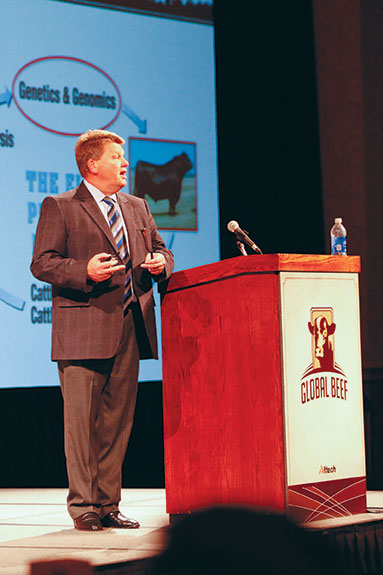
Data and genetics are longtime passions of Sand, who grew up in the agriculture industry before moving into metrology and precision manufacturing.
He turned back to his agricultural roots when he saw a need in the industry for data collection and analysis to improve the cattle production process.
After several years of analyzing data that focused on the end product’s (feeder calf) performance, he found that the test cattle in his own herd, as well as those of several Beef Connection members’ herds, performed differently.
Even though most of the cattle analyzed utilized similar high-performance genetics, including artificial insemination, the range of end product performance was unacceptable, according to Sand.
Upon investigation, it appeared the underlying factor was nutritional differences from herd to herd.
“All of these differences led me to study the concept of nutrigenomics,” says Sand. “The beef industry is already operating on a very high genetic plane; nutrition provides us an opportunity to fully express the genetic potential the industry has worked diligently to install.”
Nutrigenomics, the study of how nutrition affects genetic expression, is something Sand says will change how the beef industry thinks about nutrition.
Kate Jacques, director of nutrition at Alltech, says this newfound ability to observe which genes are affected by nutrients has the potential to revolutionize management of animal nutrition.
It marks a shift in the industry’s mindset from simply getting more nutrients in the animal to understanding how they affect animal production at the cell and tissue levels.
Scientists have found nutrients are “gene switches” that regulate biofunctions in animals. With this precise science, researchers can now find solutions that will improve animal performance and product quality.
Sand says this idea of using nutrition to improve performance isn’t new and the idea of fetal programming has been on the scene for quite some time, but putting nutrition to work for his company has made a significant difference in the results.
“Data doesn’t have eyes. It is not breed-specific and it does not have empathy,” Sand says.
“Through our research, we have seen that using these technologies, combined with proven superior genetics, has allowed for improved feed performance and carcass quality.
In our test herds, we saw minimal death loss; for a cattle producer and cattle feeder, that is huge.”
Sand now uses the term “nutritional alignment” when referring to the process of installing the nutrition in the dam before the calf is conceived to achieve “fetal programming” and having that calf on the proper nutrition until it is harvested or utilized as a replacement female.
This way, her calf receives the benefits of fetal programming at conception and will able to take advantage of that programming from conception all the way through consumption.
Improved immunity, fertility, feed performance and carcass performance data are carefully gathered and analyzed within The Beef Connection Elite Producer Program.
Sand says the Elite Producer Program offers a “suite of services” at a modest annual fee. The goal is to start slowly with sampling members’ cattle by sending a portion of their calf crop to one of the designated Beef Connection corporate feedlots.
There the animals go through the feeding and harvesting process while data is gathered and analyzed.
The program provides members a comparison of their cattle’s performance to industry standards and the ability to determine the low-performing cattle in their herd.
Based on the data collected over the course of several years, the ultimate goal is to determine and eliminate the least-productive dams or sires in the herd while seeking replacements from the top-performing cattle in the herd, placing members’ cattle performance in the top 25 percent of industry standards.
Sand says the average return to ranch per cow-calf unit is $150 to $160. Using nutrition to enhance the performance of the quality genetics that are installed is one of the ways the beef industry can adapt to higher feed costs and become more profitable.
“Organic nutrition and the things we’ve learned about fetal programming and nutrigenomics allow us to break molds and make improvements in areas we never realized before,” says Sand. ![]()
Amy Schutte is Alltech Idaho’s territory marketing coordinator.
PHOTO
Bob Sand speaks on genetic enhancements to nutrition. Photo courtesy of Alltech.








